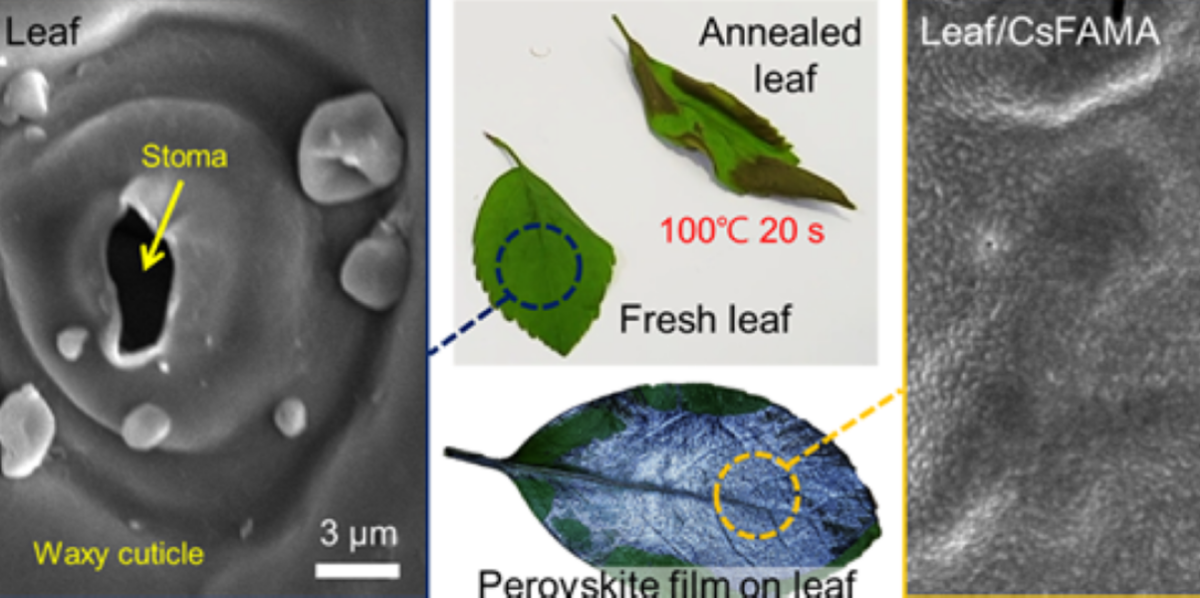An international research team has developed a method to make high-quality perovskite films at room temperature for applications in perovskite solar cells. The novel process avoids thermal annealing and additional post-treatments.
The team selected a perovskite composition known as (Csx(FA0.92MA0.08)1−xPb(I0.92Br0.08)3), which was converted into α-FAPbI3 at room temperature. Further conversion was promoted with the addition of an organic linker known as oleylamine or simply OAm. The method’s effect on quality growth patterns was confirmed by in situ X-ray monitoring.
Furthermore, to demonstrate the feasibility of the process on non-traditional PV substrates and materials, the researchers deposited their perovskite film on a plant leaf, something that would have been impossible with conventional methods.
“The most challenging aspects of the work were to understand the working mechanism and then to demonstrate that the process was gentle enough to deposit perovskite films atop fresh leaves which are very soft and fragile,” research lead author, Thuc-Quyen Nguyen, told pv magazine.
The researchers described the fabrication of cells with a planar p-i-n structure to investigate the effect of cesium (Cs) and OAm on performance and said they used only printable materials. The fabricated devices had an indium tin oxide substrate with a spin-coated layer of MeO-2PACz, which is also known as [2-(3,6-Dimethoxy-9H-carbazol-9-yl)ethyl]phosphonic acid.
Then the perovskite absorber went through a two-step spin-coating process and was connected to an electron transport layer (ETL) based on phenyl-C61-butyric acid methyl ester (PCBM) that also relied on spin coating and a bathocuproine (BCP) buffer layer. All of the previous was achieved without thermal annealing. Finally, a 100 nm thick silver metal contact was thermally deposited onto the substrates as cathodes inside a vacuum thermal evaporator.
Reproducibility was assessed via 100 devices with varying amounts of experimental materials. Observing the results, the team noted that the addition of OAm “significantly mitigated” deviations and improved device properties, and that the Cs10+OAm devices exhibited the highest short-circuit current density, open-circuit voltage, and fill factor with the smallest deviations of efficiencies.
The team said that the optimized Cs10+OAm device achieved “impressive efficiencies” of 23.2%. With an anti-reflective coating, it was increased to 24.4%. It noted that the results surpassed efficiencies attained by previous low-temperature and room-temperature (RT) processed perovskite solar cells (PSCs).
“Through a combination of characterization techniques, we unveiled the morphology and device physics of RT-processed PSCs. Finally, we demonstrated that the annealing-free processing enables the fabrication of high-quality perovskite films on leaf substrates,” concluded the researchers.
The details of the study appear in “Room-temperature-processed perovskite solar cells surpassing 24% efficiency,” published in Joule. The researchers came from three institutions, University of California, Santa Barbara, Korea’s Pusan National University, and Korea Electric Power Research Institute.
Looking ahead, the teams intend to work on integrated PV and indoor PV technologies. “Currently, we focus on the development of efficient semi-transparent solar cells that achieve efficiencies exceeding 12% while ensuring a transparency level of over 30%. These cells are designed for integration into building windows, vehicles, and greenhouses,” said Nguyen.
“Additionally, we are actively engaged in the development of indoor solar cells capable of achieving efficiencies surpassing 40% under LED lighting conditions. This breakthrough has the potential to provide renewable energy to power indoor devices and systems.”
This content is protected by copyright and may not be reused. If you want to cooperate with us and would like to reuse some of our content, please contact: editors@pv-magazine.com.








By submitting this form you agree to pv magazine using your data for the purposes of publishing your comment.
Your personal data will only be disclosed or otherwise transmitted to third parties for the purposes of spam filtering or if this is necessary for technical maintenance of the website. Any other transfer to third parties will not take place unless this is justified on the basis of applicable data protection regulations or if pv magazine is legally obliged to do so.
You may revoke this consent at any time with effect for the future, in which case your personal data will be deleted immediately. Otherwise, your data will be deleted if pv magazine has processed your request or the purpose of data storage is fulfilled.
Further information on data privacy can be found in our Data Protection Policy.